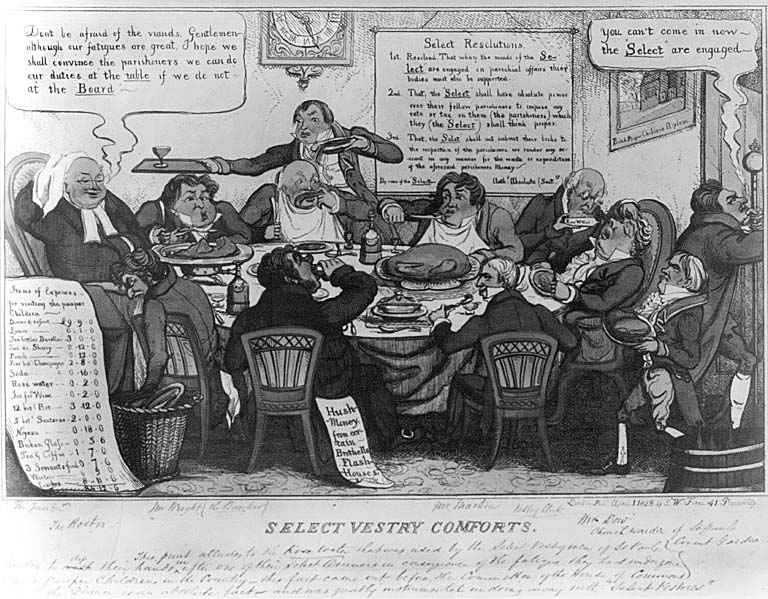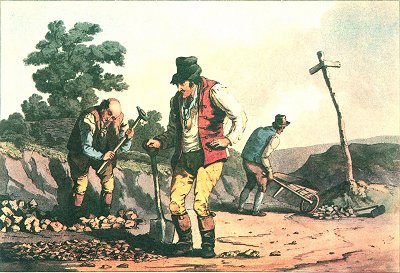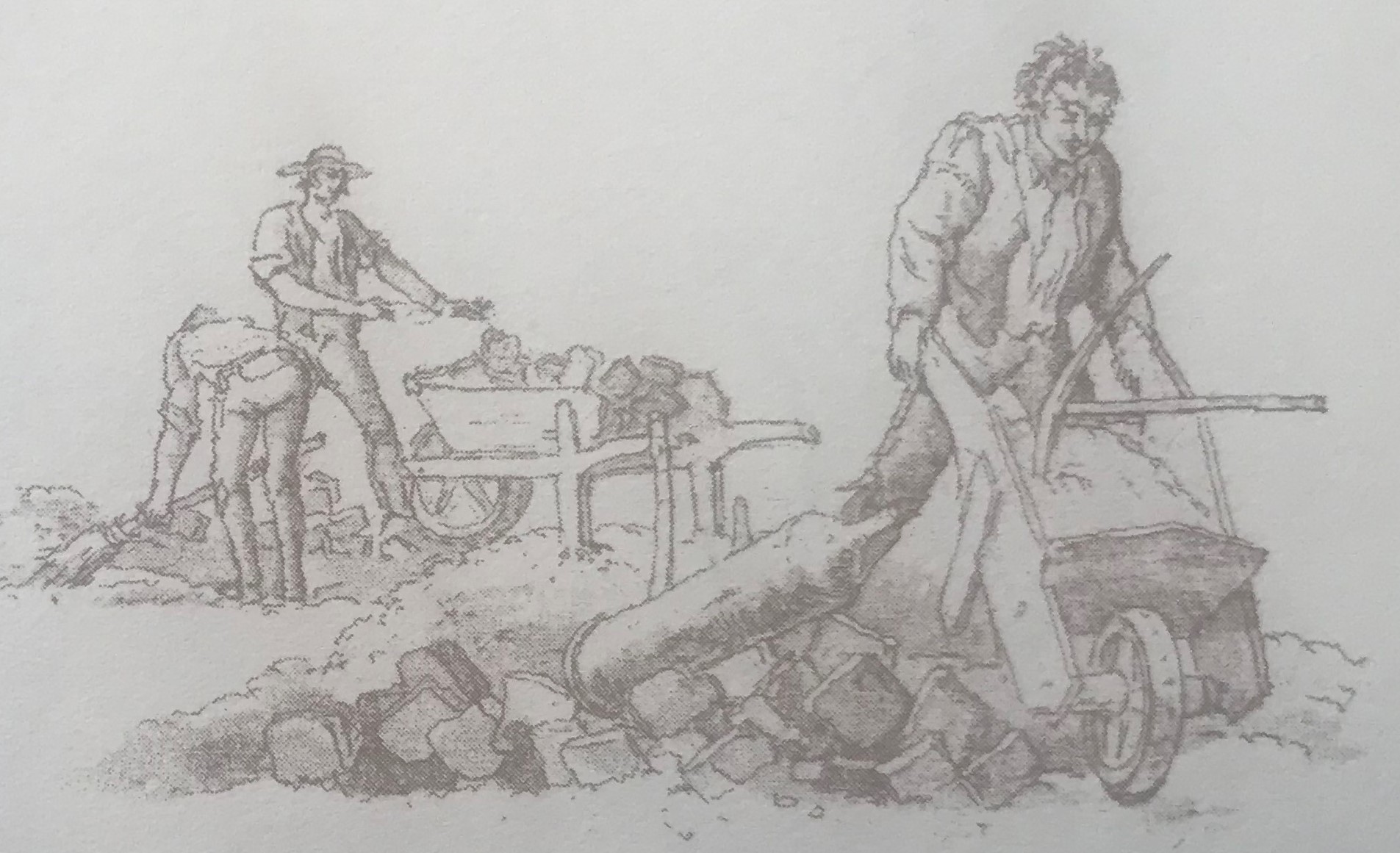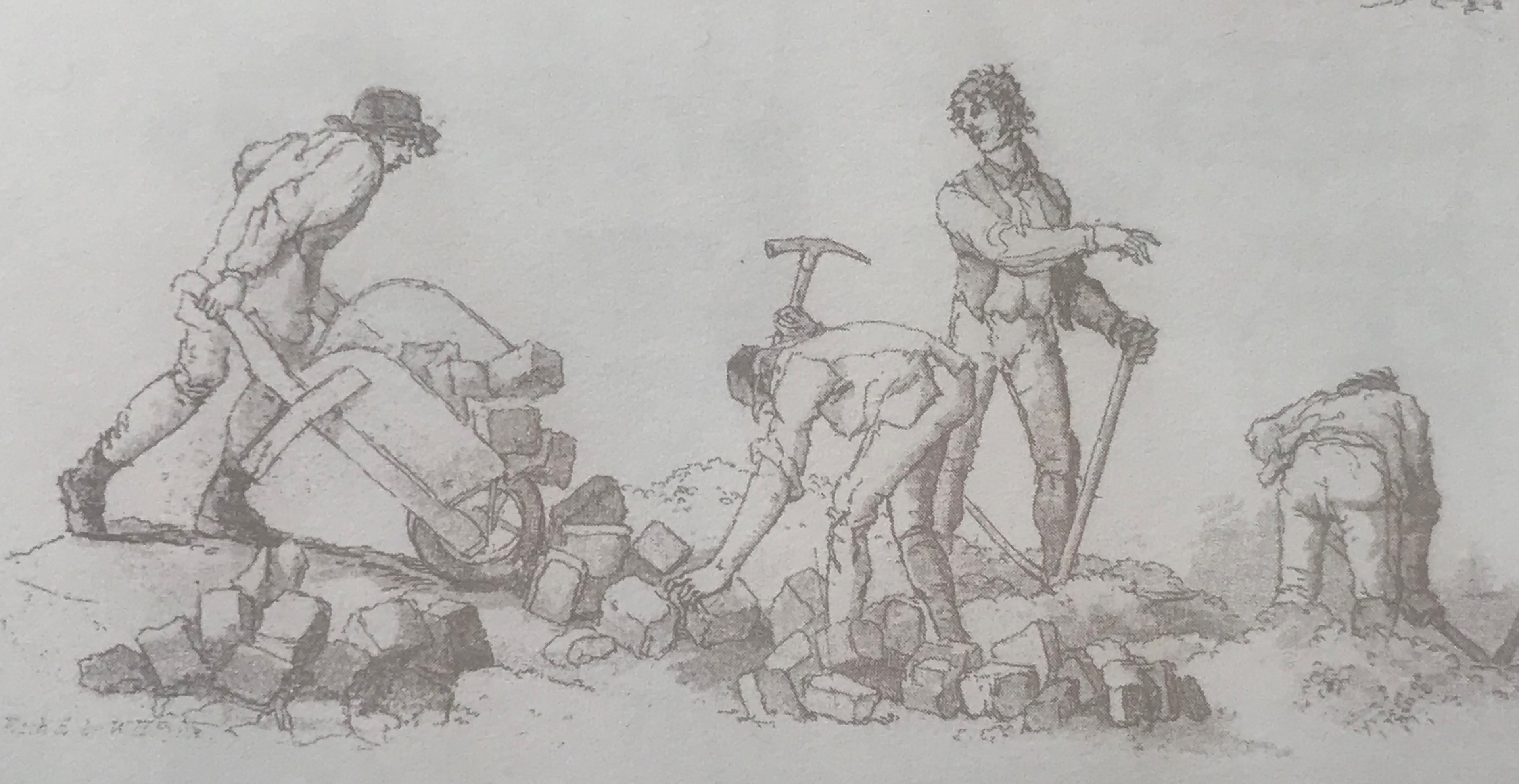Scene: Ilkeston in the 1850’s
The town’s local government
In the 1850’s Ilkeston was administered by Vestry and a Highway Board.
1830s: The Vestry meets to discuss the church condition
In 1835 Ilkeston had an estimated population of 4500 while its parish church would only hold 500 of them, and had not a single free sitting. And at the beginning of 1836 a Vestry was held where the churchwarden, Thomas Cheetham, explained that £150 was needed for repair of the pews, etc,. which would grow to £190 when other vital costs were added.
The Vestry was a group of local ‘bigwigs’, who had acquired powers mainly through custom — it became a group of the more powerful village officials, made up of important owners of property and land, and called the ‘Vestry’ because it originally met in the vestry or sacristy of the church. These people had no choice — they had to serve in their office; it was compulsory. And in return they had power within the community over its income and expenditure. The officers were the churchwardens, highway surveyors, the parish constable, overseer of the poor, and the parish clerk, sextons and scavengers.
A churchwarden was elected for one year’s duty which included various church responsibilities, and with a right to levy a ‘church rate’ if allowed by the vestry. And he had to keep accounts of all the money received and spent.
As we approach the Victorian era in Ilkeston, these important officials had names we might be familiar with (or become familiar with) … Attenborough, Ball, Barker, Beardsley, Boot, Carrier, Cheetham, Critchley, Cocker, Day, Gamble, Gregory, Harrison, Henshaw, Hobson, Kirkby, Leaper, Lowe, Mason, Meakin, Meer, Potter, Richardson, Shaw, Sills, Simpson, Skeavington, Small, Stringer, Sudbury, Taylor, Trueman, Whitehead, Whitworth, Wilcockson, Wilson.
By the Easter week of 1837 it was time for another election of the churchwarden. It should be remembered that there was no secret voting and that some of the more infleuncial townsfolk had more than one vote, because of their position.
Thomas Cheetham, nominated by Matthew Hobson, was one candidate — he stood as the ‘Radical Dissenter’ candidate, representing the non-conformist interests (Their several chapels in Ilkeston were expected to contribute to St. Mary’s expenses as well as their own). The Church party, headed by George Blake Norman, nominated Samuel Potter to stand against Thomas. At the end of March and into April a poll was taken, and after a scrutiny of the votes supervised by chairman Moses Mason, the result was a win for Thomas by one vote !! 355 to 354.
But this is where the trouble started. Several of those voting were ineligible as they weren’t ratepayers, while some were entitled to more than one vote, a fact which hadn’t been recognised. When these ‘faults’ were corrected the result was very different — Samuel collected 367 votes to Thomas’s 340 — and so the former was duly elected. This was a defeat for the Dissenters of course, who had spent money on “treating the electors“.
At least this was the situation as reported in the Nottingham Journal. Letter writers to both the Nottingham Review and the Nottingham and Newark Mercury had a different story to tell, with a different result, questioning the Journal and reporting a win for Thomas by 10 votes. This was followed by a constant stream of recriminatory letters between these newspapers, not affecting the outcome — which appears to have been that Thomas was reappointed churchwarden.
1843: A fractious Vestry meeting
By September 1843 it was time for the members at the Vestry meeting to set the Church Rates (often a contentious affair), made more so on this occasion because of the run-down state of the church’s fabric. The Rev. George set out the state of affairs, declaring that it was Common Law which bound the parishioners to agree to repair the nave of the church, and he was determined to enforce that law. John Ross, who was then Churchwarden, set out in detail what needed to be done and proposed a rate of 5d in the pound, which wasn’t really a proposal, as George pointed out, but more an order !! And no amendments were allowed !! Dr. George Lucas then pointed out that the issue could not be settled if a majority of those present opposed it. The Rev. Ebsworth was having none of it however — to him, the only issue was whether the rate which was set was high enough. Equally, Dr. Lucas stuck to his guns, while others present at the meeting now joined in.
Dr. George Blake Norman, a Conservative and Churchman, opposed the other doctor’s opinion while Matthew Hobson and Francis Ball, both Liberals and Dissenters, supported Dr. Lucas. Moses Mason then suggested the possiblity of raising the money for repairs by voluntary subscription which the Vicar said he would agree to, so long as the amount raised was sufficient.It was clear that opinion on the matter was splitting along political and religious lines, and after a powerful (and lengthy) speech by Non-conformist schoolteacher William Frederick Milner, the Vicar agreed to test the “sense of the meeting“. Of those present only 12 voted for a church rate (six of whom were joiners or bricklayers !!) while 70 voted against. At this result, Churchwarden Ross stated that he would be reluctant to now set a church rate, and there the matter rested … for the time being !!
“Thus have the parishioners of Ilkeston performed their duty, and achieved another victory over the corrupt practices of our state church” the Nottingham Review judged.
In April 1843 the parish officers were once more elected. Overseer of the Highways was John Barker while the churchwardens were John Ross and Samuel Potter. Overseer of the Poor was William Bennett and his assistant overseer and collector of the poor rate was Thomas Cheetham. Sadly Thomas didn’t serve his full term as ‘financial irregularities‘ led to his dismissal by the Poor-law Commissioners in October 1843.
Once more an occasion was presented for a political tussle between the town’s Conseravtives and Liberals as a replacement for Thomas now had to be chosen. Conservative ‘Charley’ Chadwick was one of the six candidates who entered the election for assistant, along with Liberal lacemaker William Mellor of Anchor Row. A poll was held over two days (no secret ballot of course) and it soon became clear that Charley held a slim lead over William, in second place. As the election entered its second day political ‘games‘ began in earnest. One other Conservative candidate withdrew from the contest to aid Charley’s election, as did a Liberal candidate to aid William. Soon only two candidates remained; William Severn was a young man “of respectability, well-qualified for the office, and whose character had never been stained by dishonesty or looseness of habits” and then there was Charley, about whom the popular proverb, ‘Least said, soonest mended‘, readily applied.
The contest now tightened and the Tories began to panic that William might win. Runners were sent out to round up and bring in potential supporters to vote, or to lure them with beer and silver. And these tactics worked !! As the poll closed at 5pm it soon became clear that Charley was the victor — by about 40 votes. In triumph down Bath Street, he was carried aloft, atop the shoulders of his supporters. And Charley, fond of ‘spreeing‘ and with ‘strong Bacchalanian propensities‘, was loving it. It seems that the Liberals lost this ‘fight’ through over-confidence; the Tories were organised and united, and were willing to spend in order to get their man into office (as reported by the Nottingham Review, a Liberal organ)
By March of the following year, a satisfied Nottingham Review reflected upon the several months which had just passed, during which the parish business of Ilkeston “has been conducted by an efficient committee, composed of intelligent and active trades people of the town, who have devoted a considerable share of their time in promoting the interest of the rate-payers, by paying strict attention to the accounts of the overseers, to the obtaining of rates, and as far as practicable, preventing fraud and useless expenditure”. Needless to say they were predominantly Liberals !! But it was now time once more for a new team of parish officials to be elected, and the usual political machinations were evident in the process.
——————————————————————————————————————————–
Surveyor of highways
It was the role of the village ‘surveyors of highways’ also known as the Overseer of the Highway, to make sure that the Ilkeston roads were kept in good order … that is all the roads except the turnpike road, a sort of main road which came from the direction of Nottingham and went on towards Derby (or vice-versa if you care to think of it that way) … we shall come to this Turnpike Road eventually and see how it was different.
The other ‘minor’ roads around the village were looked after by the surveyor who, since 1773, was paid a salary by the rate-payers … but not very much .. his role was not relatively important !!
By the 1830’s it seemed the custom that the Vestry chose one surveyor. Of course he was not expected to do all repairs and maintenance himself … statute stipulated that he could order parishioners to work for him but from 1835 (by the General Highway Act) this right was abolished and the surveyor now hired labour in the usual way.
In 1837 the vestry went back to an older method of chosing the surveyor … that is, making a list of 12 possible candidates, sending it to the local J.P. and letting him chose.
At the same time a committee was appointed to inspect the roads.
The overseer of the highways had to collect the highway rate himself, and excellent way of keeping the rates down, but not of encouraging the construction of good roads.This department suffered, like all the others, from being based on too small a unit…. the parish. 18th and 19th century Ilkestonians thought if the Ilkeston roads sufficed for Ilkestonians, that was good enough. Anyhow, let those who went gadding about the country pay for the roads or else do what the average villager was perfectly content to do … “stop at ‘om”. (Waterhouse)
Roads were improved by paving .. that is, by laying a stratum of gravel or small broken stones on the soil. The thickness of this layer was determined by the nature of the ground, or by the availability of materials in the nearby area. It might vary from a three or four inches to a foot or more. A road made of broken stones, though firm, was not the most comfortable to travel along, nor best for the feet of horses.
In 1842, at the time that a new Town Hall for Ilkeston was being discussed, so too were improvements in access roads into the town under review. One such road was a new carriage road, across “the Meadows” and on to Cossall, Awsworth and Newthorpe; this would begin at the end of what what was later, Awsworth Road, at the site of the Bridge Inn, and continue along the route of what was later Newton’s Lane. Such a road would ease the passage of transport between those places and Ilkeston, and so increase the town’s trade; at present traffic had to take a very roundabout route either via Trowell or Heanor. And it wasn’t long before this road was being constructed — by the beginning of October, 1842.
The Highway Board
Then in 1844 the compulsory highway overseers ended and a Highway Board was set up…. the Board for Repair of the Highways in the Parish of Ilkeston. According to Trueman and Martson, this Highway Board was “first formed about 1849, and corresponded to the old surveyors of the Highway elected by the parishioners”. This date however is contested by Edgar Waterhouse who suggests that its formation was in the year 1844. In an article appearing in the Ilkeston Pioneer entitled ‘Local Government Two Centuries Ago’ [Dec 21st 1934] he lists the names of all the overseers of the Highways he had managed to find from the highways accounts, dating from 1742. The last names in that list are John Barker and Samuel Potter, overseers in 1843.
Waterhouse then writes ‘In 1844 the compulsory overseers ended, when at the Easter Vestry “it was proposed by Mr. Longstaff and seconded by Mr. Moses Mason that, in lieu of the present surveyor of the highways a board be appointed and called the Board for the Repair of the Highways in the Parish of Ilkeston” It appears that this motion was carried unanimously and 14 persons were then chosen to form that Board, whereupon John Barker handed over his highway rate book to the new Board.
This Highway Board didn’t impress the Nottingham Guardian (December 3rd, 1847). It reported upon the dreadful condition of the village’s roads. The causeways of the Common, Bath Street, Chapel Street, Pimlico and Nottingham Road were all in worse state than the actual roadway. The Board would sooner see its constituents splattered with black coal sludge, while the gutters and dikes at the sides of the streets were full of unspeakable nastiness which would engulf any infant or drunk, if they were to fall into them, and would cause their certain death.
By the mid 1850’s the Pioneer was constantly and scathingly critical of the Highway Board and its Surveyor. The Board was simply a ‘talking shop’ made up of ‘sorry ingredients’ and the Surveyor should ‘try to earn the liberal salary that was paid to him’.
The roads through the Common and into Cotmanhay were singled out in particular by the newspaper as in need of care and attention, although the Pioneer did note, perhaps with reluctance, some improvement in the foot road to ‘Moore’s Bridge’ (the Derby Road route). There were reports of the contents of privies and ash-pits being thrown out onto the Cotmanhay Road at the Common, in Bath Street and in South Street.
Middle Road at the Common had heaps of dirt on each side for weeks on end.
In 1854 Mrs. Hitchcock met with a ‘frightful accident’ in Chapel Street when the pony pulling her carriage shied at a quantity of lime and rubbish left in the narrow street. A wheel caught the corner of the Slade Chapel, the cart was upset and a shaft broken….but no serious hurt to Mrs. H. and her children.
The Pioneer however felt compelled to repeat its complaint to townsmen about leaving obstructions in the street.
To drive home the point about the state of the roads and the town in general, the newspaper printed an account of a working man as he took his family for a walk and a horse-carriage ride around the town on two summer evenings.
As a result of the condition of the town’s roads, the man listed a number of complaints and minor disasters as he and his family took their journey …..a cut face and a sprained ankle for his son on the causeway in East Street, pigsty and manure smells, black poisonous smoke from the chimney of the Water-works, a stinking ditch that induced severe vomiting and fainting in his wife, a stone-throwing urchin, a drunken brawl, and on the way down Nottingham Road, a group of Kensington women and boatmen arguing and swearing.
However once outside of the town and into Trowell he encountered a different world of country cottages, rose gardens, a picturesque village school, trees and pure fresh air.
And then coming back into Ilkeston via Awsworth Road the family’s troubles reappeared as a large stone in the middle of the road broke a spring in the carriage. The family struggled on only for the horse — borrowed from a neighbour — to step onto the tram-road at the bottom of Bath Street and ‘break his knees’.
With his son now being carried home by a friend and his wife seeking refuge in a nearby cottage, the man tried to coax the lame horse up Bath Street, still pulling the cart, when it was struck by a runaway horse coming down the hill. A broken shaft was the result.
The family did manage to reach the shelter of their own home when there was a knock on the door. It was Mr Pink, the highway collector, asking for his rate!
In July 1856 the Pioneer was still at it ….. Board of Highways was a talking shop, with its do-nothing propensity. Its members compliment each other in long speeches, indulge in specious promises, besmear each other with flattering unction and then hope to gain the approval of the ratepayers when it is time to appoint again. “We frankly avow we have no great expectation from the Board, made up as it is of such sorry ingredients, but we do hope that their spirited and energetic Surveyor will try to earn the salary which has been so freely voted, and that the remaining members of the Board may indulge their idle and mischievous propensities, without damage to the public good, or accidents to her Majesty’s liege subjects!”
Eventually, in 1857, Matthew Hobson, chairman of the Board of Highways, announced that anyone who wilfully obstructed any carriage or footway with scaffolding, bricks, mortar, stones or the like, would be prosecuted.
——————————————————————————————————————————–
Ilkeston’s improvements ?
In March 1854 the Ilkeston Pioneer (at that time, the town’s only newspaper, first printed in 1853) included a letter from one of its readers Tilchestune … it was usual for correspondents to use ‘pen-names’ rather than their own names.
As he walked around the town, Tilchestune was extremely happy with what he saw and was eager to share his thoughts …
In a letter (abbreviated below) headed Ilkeston and its improvements he wrote …
Who that knew anything of Ilkeston fifteen or twenty years ago, has not noticed with pleasure the great improvements that have been effected in the almost entire re-construction of the roads through Kensington (down Nottingham Road), South-street, Market-place, Pimlico, East-street, Burr-lane, and Bath-street? (Anyone not familiar with the geography of Ilkeston will see most of these places shown on the earlier sketch map)
Mount Sorrel gutters and crossings, and stone and brick causeways, with curbings, have been laid, which have given our streets an air of cleanliness and finish they never before exhibited.
Numerous encroachments and nuisances on the highway have been abated or removed — The unsightly ancient projection in the centre of the Market-place, has given place to two good shops, the space between being crowned with a light and graceful platform, from which we hope, ere long, to see the member for Ilkeston harangue his constituents; and the removal of the old brick wall and stiff poplars has given us as pleasant a promenade as any little market town can boast of.
The four-feet ditches of filth, which bounded nearly all one side of Bath-street, have given place to a foot-road, which, though not the best, we must take as the ‘pioneer’ for a better one ‘looming in the future’.
Who that recollects the pool against the Toll-bar, and Weaver-pool in South-street (both alike the occasion of so much excitement, personality, and lawyer-meddling) will not admit that the filling up of one (at the Toll Bar), and the erections now rising on the site of the other (the property of our old townsman, Mr. Sudbury), are improvements ?
Pimlico has lost the old Independent meeting-house, with which are dearly associated the names of (Joshua) Shaw and (James Adolphus) Savage, once its gifted ministers, but in its place now stands the best specimen of ecclesiastical architecture in the town belonging to dissenters.
If we cross over to the Market-place, and tread the ground where once a beloved (Richard) Moxon (curate of the Ilkeston parish 1823-1836) lived and laboured for the Church, what a change do we see ! The tumble-down cot, styled ‘the vicarage’, in which he resided, is supplanted by a comfortable hall-like parsonage; and the grounds on which donkeys used to browse, are now laid out in beautiful parterres, shrubbery, &c. While in this nook, we cannot but revert to the removal of the pump in Anchor-row. Is this not an improvement ?
.. we pass on, — The British and National schools erected speak well for the improvement of Ilkeston.
Among our little streets, East-street has done its share to improve the appearance of the place, and the respected occupant of Dalby House (Dr. George Blake Norman) deserve the best thanks of the walk-loving public, for the pleasant road he has made in the croft below his residence.
The spacious Cricket-ground is also one of our recent improvements, and forms a most enticing resort for health-seekers.
The Wesley and Bath-street chapels are no mean ornaments to our town.
From the Rutland Arms and Baths to the Wine Vaults, at the top of Bath-street, improvements have been made by the Railway Company, Mr. Chadwick, Mr. W. Riley, Mr. Thomas Riley, Mr. Burgin, Mr. Rose, Mr. Potter, Mr. W. Ball, Mr. Aldred, Mr. Evans. Mr. Lowe, Mr. Carrier, and others.
The ‘Common’, with its little ‘Ebenezer‘, and the proving-hands and taste of a Richards, a Beardsley, a Whitehead, and a Bailey, keeps pace with its parent, the town. Whether we go to the Park or the Manor-house; to Kensington with its ‘Field-house‘; or Cotmanhay, with its Church (Christ Church) and Parsonage; the Pottery, or the Wharf, everywhere are we met by signs of improvement in property and the general appearance of the place.
In this rapid enumeration of improvements, we ought not to forget the new phasis given to that locality known as ‘Albion-place‘ by the erection of the large lace factory, warehouse, and other premises of Messrs. Ball. The stimulus given to the improvements of Ilkeston, and the extension of its trade, by the erection of industrial hives of this kind, and those of Messrs. Carrier, Messrs. Fletcher, and Messrs. Bailey, Son, and Co., cannot be over-valued or prized by anyone having the real weal of Ilkeston at heart.
dated Feb. 28, 1854
(We shall visit most of these places and meet many of the people as we journey on through town).
——————————————————————————————————————————–
In 1864 this system of local governance was reformed when the Local Board was introduced to replace the Highway Board.
But not before the ‘lighting issue’ of the 1850’s.





